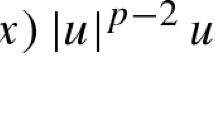Abstract
We consider the Schrödinger–Poisson system in the repulsive (plasma physics) Coulomb case. Given a stationary state from a certain class we prove its nonlinear stability, using an appropriately defined energy-Casimir functional as Lyapunov function. To obtain such states we start with a given Casimir functional and construct a new functional which is in some sense dual to the corresponding energy-Casimir functional. This dual functional has a unique maximizer which is a stationary state of the Schrödinger–Poisson system and lies in the stability class. The stationary states are parameterized by the equation of state, giving the occupation probabilities of the quantum states as a strictly decreasing function of their energy levels.
Similar content being viewed by others
REFERENCES
N. Angelescu, M. Pulvirenti, and A. Teta, Derivation and classical limit of the mean-field equation for a quantum Coulomb system: Maxwell-Boltzmann statistics, J. Statist. Phys. 74:14–165 (1994).
V. I. Arnol'd, Conditions for nonlinear stability of stationary plane curvilinear flows of an ideal fluid, Sov. Math. Dokl. 6:77–776 (1965).
V. I. Arnol'd, On an a priori estimate in the theory of hydrodynamical stability, Amer. Math. Soc. Transl., Series 2 79:26–269 (1969).
C. Bardos, F. Golse, and N. J. Mauser, Weak coupling limit of the N-particle Schrödinger equation, preprint (2000).
F. Brezzi and P. A. Markowich, The three-dimensional Wigner-Poisson problem: Existence, uniqueness and approximation, Math. Meth. Appl. Sci. 14:3–62 (1991).
H. G. B. Casimir, ber die Konstruktion einer zu den irreduziblen Darstellungen halbeinfacher kontinuierlicher Gruppen gehörigen Differentialgleichung, Proc. R. Soc. Amsterdam 34:84–846 (1931).
F. Castella, L 2-solutions to the Schrödinger-Poisson system: Existence, uniqueness, time behaviour, and smoothing effects, Math. Mod. Meth. Appl. Sci. 7:105–1083 (1997).
J. M. Chadam and R. T. Glassey, Global existence of solutions to the Cauchy problem for time dependent Hartree equations, J. Math. Phys. 16:112–1130 (1975).
P. Degond and F. Nier, Etude des solutions stationnaires de l'équation de Wigner, private communication.
J. Dolbeault and P. A. Markowich, Unterreiter, A: On singular limits of mean-field equations, Arch. Rat. Mech. Anal., to appear.
I. Ekeland and R. Temam, Convex Analysis and Variational Problems (North-Holland, New York, 1976).
I. Gasser, R. Illner, P. A. Markowich, and C. Schmeiser, Semiclassical, t ? ? asymptotics and dispersive effects for the Hartree-Fock systems, Math. Mod. and Num. Anal. 32:69–713 (1998).
Y. Guo, Variational method in polytropic galaxies, Arch. Rational Mech. Anal. 150:20–224 (1999).
Y. Guo, On the generalized Antonov's stability criterion, Contem. Math. 263:8–107 (2000).
Y. Guo and G. Rein, Stable steady states in stellar dynamics, Arch. Rational Mech. Anal. 147:22–243 (1999).
Y. Guo and G. Rein, Existence and stability of Camm type steady states in galactic dynamics, Indiana University Math. J. 48:123–1255 (1999).
Y. Guo and G. Rein, Isotropic steady states in galactic dynamics, Commun. Math. Phys. 219:60–629 (2001).
D. D. Holm, J. E. Marsden, T. Ratiu, and A. Weinstein, Nonlinear stability of fluid and plasma equilibria, Phys. Rep. 123:–116 (1985).
P. A. Markowich, Boltzmann distributed quantum steady states and their classical limit, Forum Math. 6:–33 (1994).
F. Nier, A stationary Schrödinger-Poisson system arising from the modelling of electronic devices, Forum Math. 2:48–510 (1990).
F. Nier, A variational formulation of Schrödinger-Poisson systems in dimension d ⩽ 3, Commun. Partial Differential Equations 18:112–1147 (1993).
F. Nier, Schrödinger-Poisson systems in dimension d ⩽ 3: the whole-space case, Proc. Roy. Soc. Edinburgh Sect. A 123:117–1201 (1993).
G. Rein, Nonlinear stability for the Vlasov-Poisson system-the energy-Casimir method, Math. Meth. Appl. Sci. 17:112–1140 (1994).
G. Rein, Flat steady states in stellar dynamics-existence and stability, Commun. Math. Phys. 205:22–247 (1999).
H. Spohn, Quantum kinetic equations, in On the Three Levels, M. Fannes et al., eds. (Plenum Press, New York, 1994), pp. –10
G. Wolansky, On nonlinear stability of polytropic galaxies, Ann. Inst. Henri Poincaré 16:1–48 (1999).
G. Wolansky, Static solutions of the Vlasov-Einstein system, preprint (2000).
Author information
Authors and Affiliations
Rights and permissions
About this article
Cite this article
Markowich, P.A., Rein, G. & Wolansky, G. Existence and Nonlinear Stability of Stationary States of the Schrödinger–Poisson System. Journal of Statistical Physics 106, 1221–1239 (2002). https://doi.org/10.1023/A:1014050206769
Issue Date:
DOI: https://doi.org/10.1023/A:1014050206769



